使用 spring-security-oauth2 體驗 OAuth 2.0 的四種授權模式
2022-07-10 21:00:41
目錄
背景
一直對OAuth 2.0的四種授權模式比較好奇,瞭解的僅限網上的資料,沒有使用程式碼體驗過,這次使用spring-security-oauth2來體驗這四種模式的整個過程。
相關程式碼
pom檔案
<dependencies>
<dependency>
<groupId>org.springframework.boot</groupId>
<artifactId>spring-boot-starter-security</artifactId>
<version>2.1.4.RELEASE</version>
</dependency>
<dependency>
<groupId>org.springframework.boot</groupId>
<artifactId>spring-boot-starter-web</artifactId>
<version>2.1.4.RELEASE</version>
</dependency>
<dependency>
<groupId>org.springframework.security.oauth</groupId>
<artifactId>spring-security-oauth2</artifactId>
<version>2.0.16.RELEASE</version>
<exclusions>
<exclusion>
<artifactId>spring-core</artifactId>
<groupId>org.springframework</groupId>
</exclusion>
<exclusion>
<artifactId>spring-context</artifactId>
<groupId>org.springframework</groupId>
</exclusion>
<exclusion>
<artifactId>spring-beans</artifactId>
<groupId>org.springframework</groupId>
</exclusion>
<exclusion>
<artifactId>spring-security-core</artifactId>
<groupId>org.springframework.security</groupId>
</exclusion>
</exclusions>
</dependency>
<dependency>
<groupId>com.google.guava</groupId>
<artifactId>guava</artifactId>
<version>26.0-jre</version>
</dependency>
</dependencies>
設定類
@Configuration
@EnableAuthorizationServer
public class MyAuthorizationServerConfigurerAdapter extends AuthorizationServerConfigurerAdapter {
@Override
public void configure(ClientDetailsServiceConfigurer clients) throws Exception {
clients
.inMemory()
.withClient("clientUser")
.secret("{bcrypt}" + new BCryptPasswordEncoder().encode("123456"))
.authorizedGrantTypes("authorization_code", "implicit", "password", "client_credentials");
}
@Override
public void configure(AuthorizationServerEndpointsConfigurer endpoints) {
DaoAuthenticationProvider daoAuthenticationProvider = new DaoAuthenticationProvider();
UserDetails userDetails = User.withUsername("username")
.password("{bcrypt}" + new BCryptPasswordEncoder().encode("password"))
.roles("123")
.build();
InMemoryUserDetailsManager inMemoryUserDetailsManager = new InMemoryUserDetailsManager(userDetails);
daoAuthenticationProvider.setUserDetailsService(inMemoryUserDetailsManager);
AuthenticationManager authenticationManager = new ProviderManager(
Lists.<AuthenticationProvider>newArrayList(daoAuthenticationProvider));
endpoints.authenticationManager(authenticationManager);
}
}
@Configuration
@EnableWebSecurity
public class SecurityConfig extends WebSecurityConfigurerAdapter {
@Bean
public InMemoryUserDetailsManager inMemoryUserDetailsManager(
SecurityProperties properties) {
SecurityProperties.User user = properties.getUser();
List<String> roles = user.getRoles();
return new InMemoryUserDetailsManager(User.withUsername("user")
.password("{bcrypt}" + new BCryptPasswordEncoder().encode("123456"))
.roles(StringUtils.toStringArray(roles)).build());
}
}
啟動類
@SpringBootApplication(
exclude = UserDetailsServiceAutoConfiguration.class
// excludeName = "org.springframework.boot.autoconfigure.security.servlet.UserDetailsServiceAutoConfiguration"
)
public class SpringSecurityStudyApplication {
public static void main(String[] args) {
SpringApplication.run(SpringSecurityStudyApplication.class, args);
}
}
授權碼模式
第一步 存取GET /oauth/authorize
相關程式碼在org.springframework.security.oauth2.provider.endpoint.AuthorizationEndpoint
org.springframework.security.oauth2.provider.endpoint.WhitelabelApprovalEndpoint
請求引數和返回結果如下:
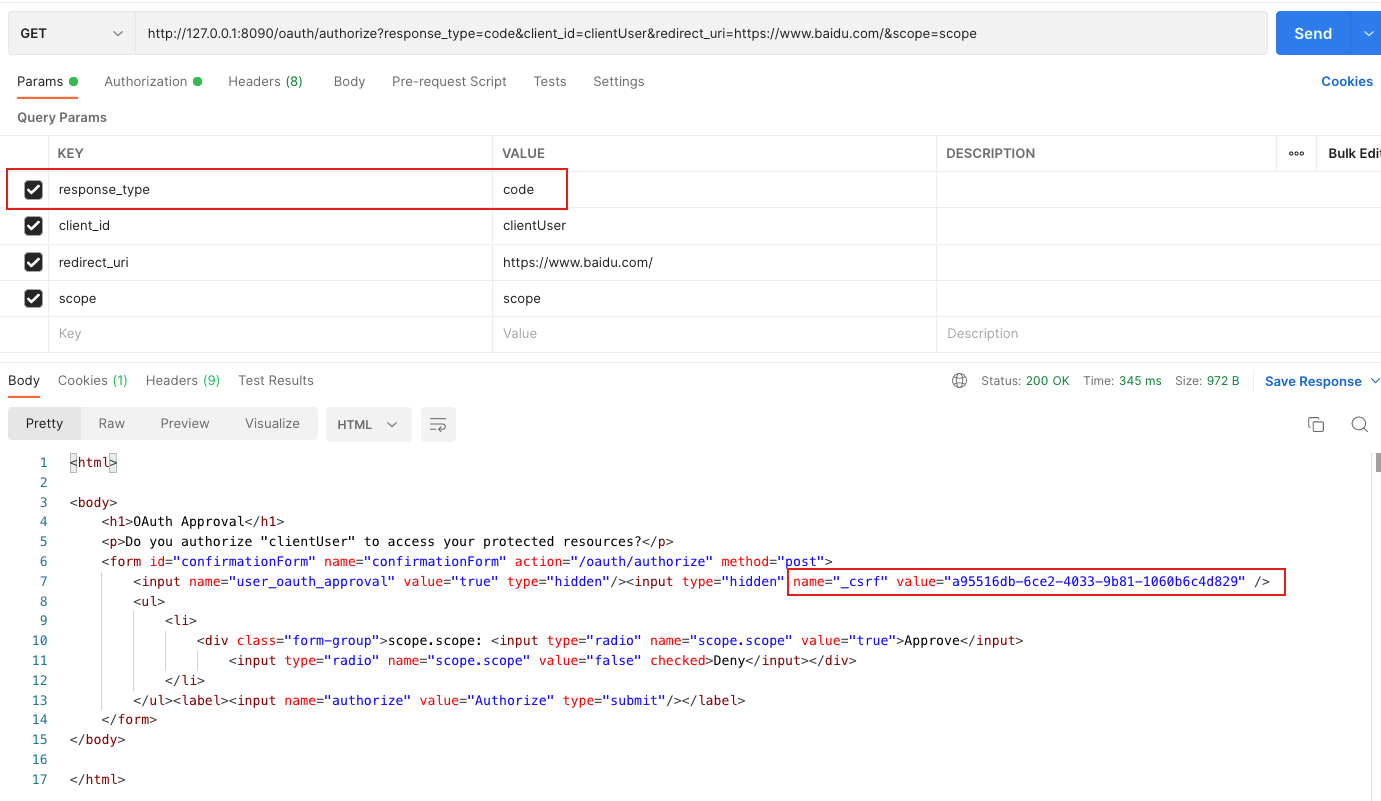
返回結果在瀏覽器上展示的話,是讓使用者來勾選是否同意授權的一個頁面,還有返回結果的_csrf的值要作為第二步的引數。
curl如下:
curl --location --request GET 'http://127.0.0.1:8090/oauth/authorize?response_type=code&client_id=clientUser&redirect_uri=https://www.baidu.com/&scope=scope' \
--header 'Authorization: Basic dXNlcjoxMjM0NTY=' \
--header 'Cookie: JSESSIONID=AB254815273DB81F1F3BAF74E94DAAB6'
第二步 存取POST /oauth/authorize
相關程式碼在org.springframework.security.oauth2.provider.endpoint.AuthorizationEndpoint
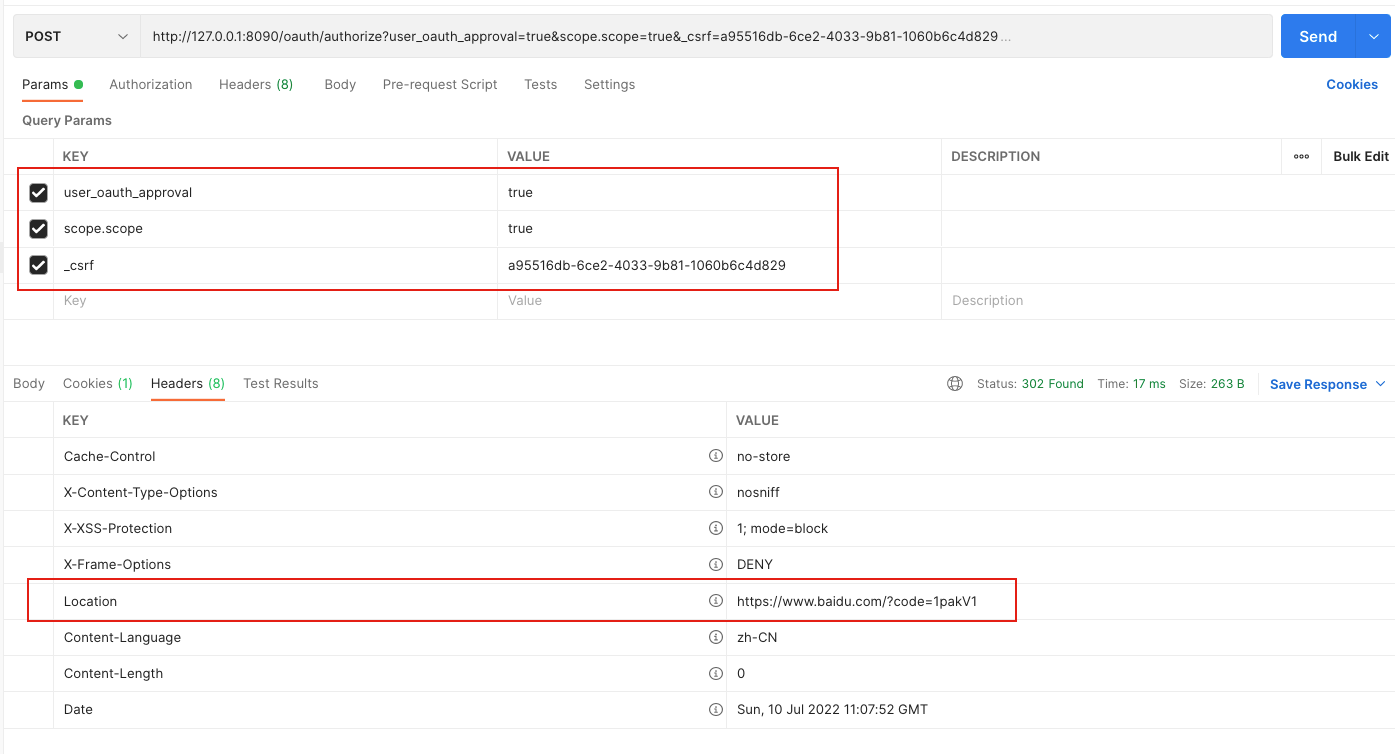
crul如下:
curl --location --request POST 'http://127.0.0.1:8090/oauth/authorize?user_oauth_approval=true&scope.scope=true&_csrf=a95516db-6ce2-4033-9b81-1060b6c4d829' \
--header 'Cookie: JSESSIONID=73E846796ACB7818E09B93AC4CFD320D'
_csrf 要使用第一步返回的結果,在返回頭的Location裡可以得到授權碼
第一個引數必須要有,因為:
<input name="user_oauth_approval" value="true" type="hidden"/>
@RequestMapping(value = "/oauth/authorize", method = RequestMethod.POST, params = OAuth2Utils.USER_OAUTH_APPROVAL)
public View approveOrDeny(@RequestParam Map<String, String> approvalParameters, Map<String, ?> model, SessionStatus sessionStatus, Principal principal) {
}
public static final String USER_OAUTH_APPROVAL = "user_oauth_approval";
第二個引數是使用者是否同意授權
第三步 存取POST /oauth/token
相關程式碼在org.springframework.security.oauth2.provider.endpoint.TokenEndpoint
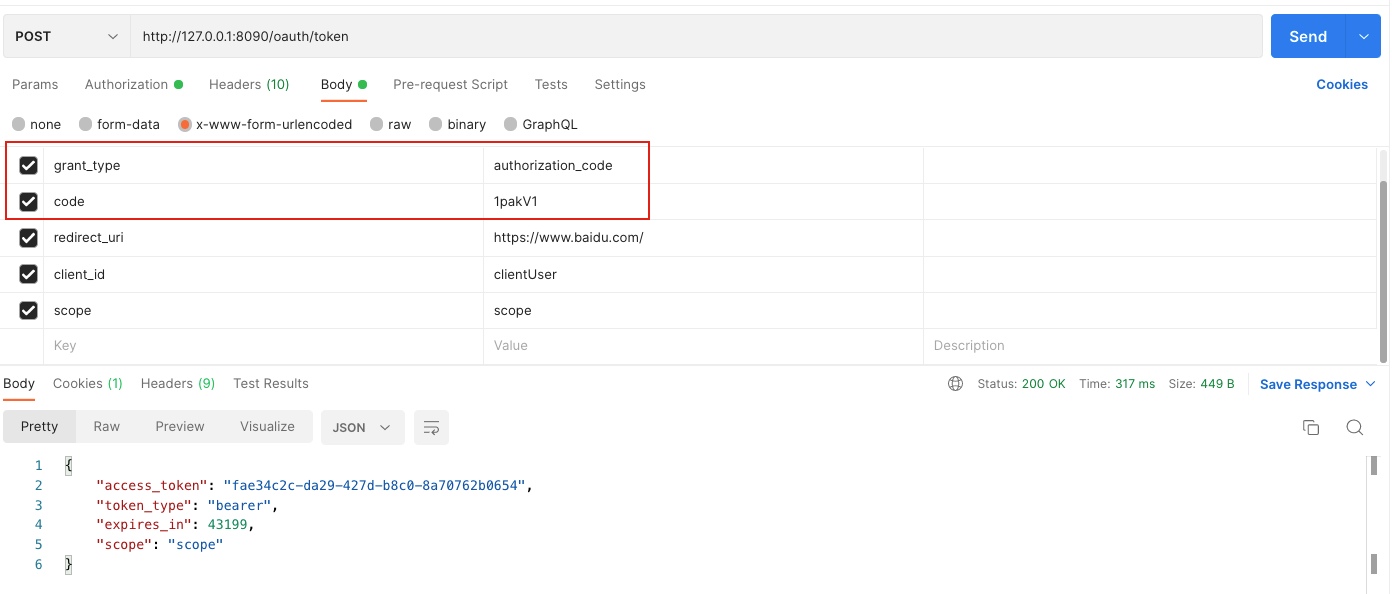
code 使用第二步的返回結果
crul如下:
curl --location --request POST 'http://127.0.0.1:8090/oauth/token' \
--header 'Authorization: Basic Y2xpZW50VXNlcjoxMjM0NTY=' \
--header 'Content-Type: application/x-www-form-urlencoded' \
--header 'Cookie: JSESSIONID=5D41BF01BC875BDF266D3C2178537F21' \
--data-urlencode 'grant_type=authorization_code' \
--data-urlencode 'code=1pakV1' \
--data-urlencode 'redirect_uri=https://www.baidu.com/' \
--data-urlencode 'client_id=clientUser' \
--data-urlencode 'scope=scope'
簡化模式
第一步 存取GET /oauth/authorize
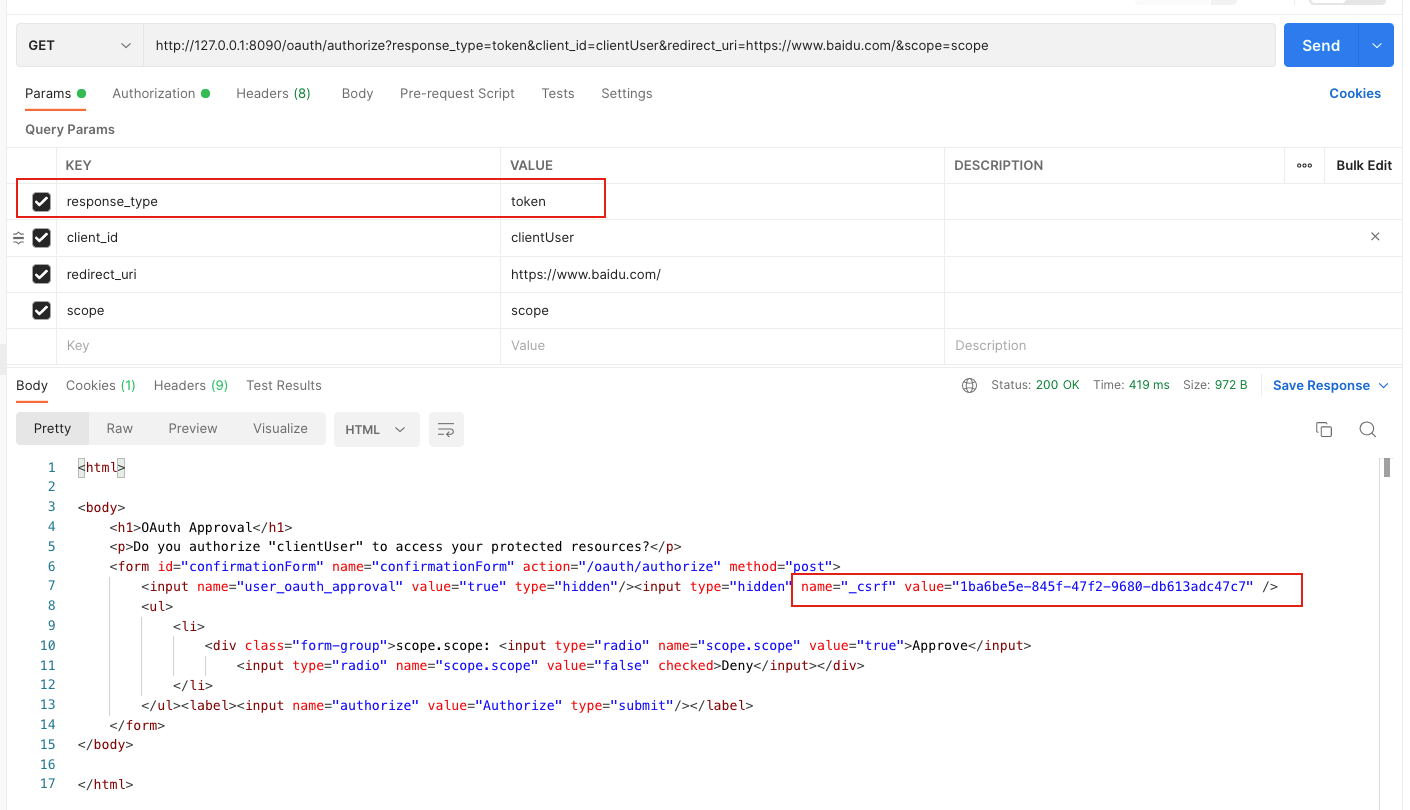
crul如下:
curl --location --request GET 'http://127.0.0.1:8090/oauth/authorize?response_type=token&client_id=clientUser&redirect_uri=https://www.baidu.com/&scope=scope' \
--header 'Authorization: Basic dXNlcjoxMjM0NTY=' \
--header 'Cookie: JSESSIONID=6AD429F6CF30C10C0E9F1A35EC78A790'
第二步 存取POST /oauth/authorize
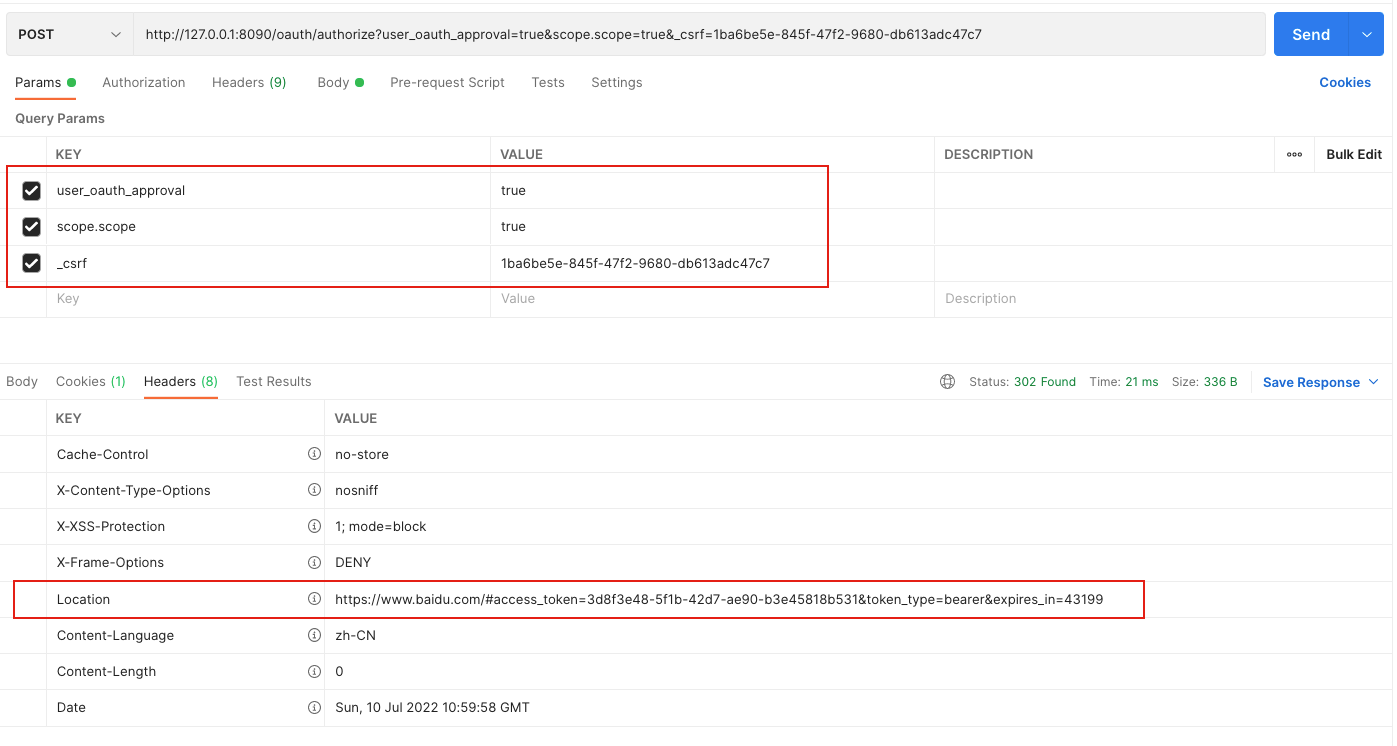
crul如下:
curl --location --request POST 'http://127.0.0.1:8090/oauth/authorize?user_oauth_approval=true&scope.scope=true&_csrf=1ba6be5e-845f-47f2-9680-db613adc47c7' \
--header 'Cookie: JSESSIONID=6AD429F6CF30C10C0E9F1A35EC78A790'
密碼模式
直接存取POST /oauth/token
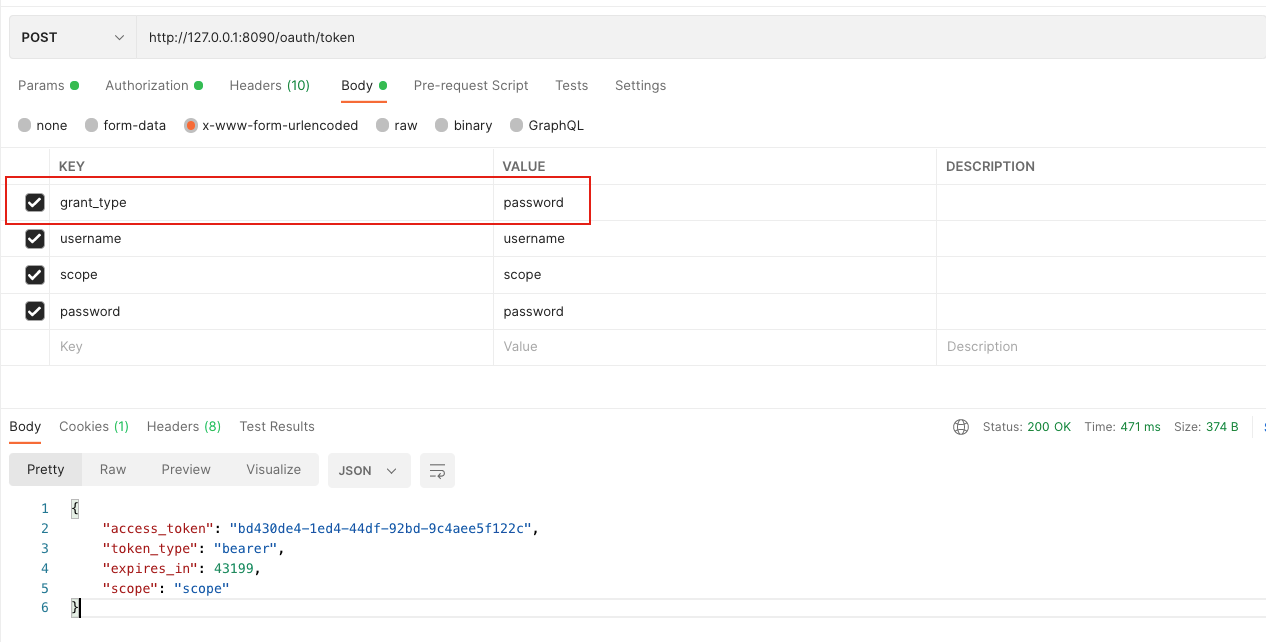
curl如下:
curl --location --request POST 'http://127.0.0.1:8090/oauth/token' \
--header 'Authorization: Basic Y2xpZW50VXNlcjoxMjM0NTY=' \
--header 'Content-Type: application/x-www-form-urlencoded' \
--header 'Cookie: JSESSIONID=7E149951AB7D3C03E31E21450754DAAE' \
--data-urlencode 'grant_type=password' \
--data-urlencode 'username=username' \
--data-urlencode 'scope=scope' \
--data-urlencode 'password=password'
使用者端模式
直接存取POST /oauth/token
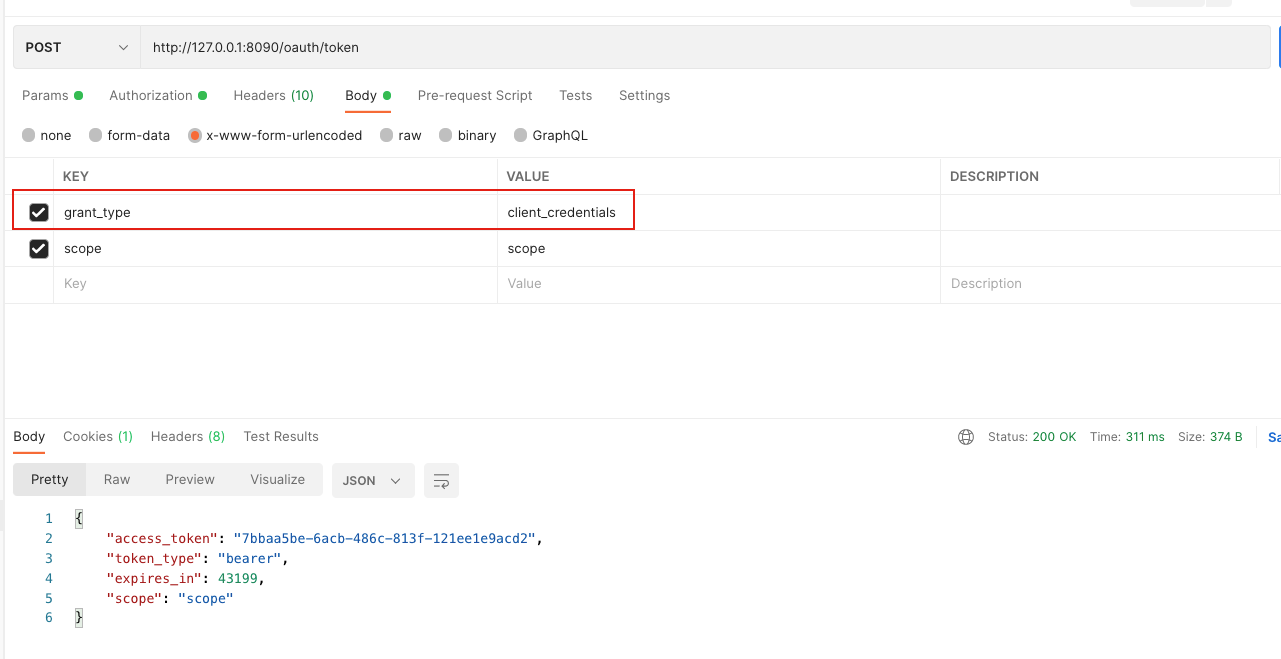
curl如下:
curl --location --request POST 'http://127.0.0.1:8090/oauth/token' \
--header 'Authorization: Basic Y2xpZW50VXNlcjoxMjM0NTY=' \
--header 'Content-Type: application/x-www-form-urlencoded' \
--header 'Cookie: JSESSIONID=7E149951AB7D3C03E31E21450754DAAE' \
--data-urlencode 'grant_type=client_credentials' \
--data-urlencode 'scope=scope'